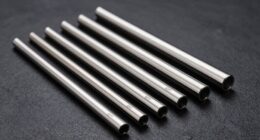Choosing the right bike frame material is essential for your comfort and performance. If you're lighter, consider carbon fiber for its responsiveness. For heavier riders, steel or titanium offers durability and great shock absorption. Aluminum frames are affordable and light but may not absorb bumps as well. Think about your riding style too; racing requires a stiffer frame like carbon, while touring benefits from steel's natural comfort. Frame geometry also plays a role in your experience. Keep exploring to discover the nuances of each material and how they suit your unique riding preferences.
Key Takeaways
- Heavier riders over 200 lbs should opt for steel or titanium frames for enhanced durability and shock absorption.
- Carbon fiber is best for competitive cycling due to its lightweight and stiffness, but may not suit heavier riders.
- Aluminium frames are affordable and lightweight, making them ideal for urban commuting, but may be less forgiving on rough terrains.
- Steel frames provide excellent comfort and shock absorption, making them ideal for touring and long-distance rides.
- Frame geometry is crucial; aggressive designs cater to performance riders, while relaxed angles are better for casual cycling.
Importance of Frame Selection
When it comes to cycling, choosing the right frame material is essential. The bike frame serves as the backbone of your bicycle, directly influencing your strength, stability, and overall performance. Lighter materials like carbon fiber can enhance your ride, but it's vital to take into account your rider weight. If you're on the heavier side, you might find that steel or titanium offers the durability and flexibility you need for a comfortable ride.
Additionally, understanding the effects of various environmental factors, such as weather conditions, can impact your riding experience and frame selection; for example, safety gear is critical for ensuring protection while cycling in diverse conditions.
Understanding the geometry of the frame is also key. Aggressive angles may suit competitive riders looking for performance benefits, while relaxed angles cater to those seeking a more comfortable cycling experience. The manufacturing process, including butting and welding quality, greatly impacts the frame's strength-to-weight ratio, ensuring it meets your specific needs.
Ultimately, a well-selected frame material not only enhances your cycling experience but also provides the right balance of comfort, performance, and durability tailored to your individual riding style and conditions.
Overview of Frame Materials

Numerous frame materials are available for cyclists, each offering unique advantages and disadvantages that cater to different riding styles and preferences. Understanding these options can help you choose the best bike for your needs.
| Frame Material | Key Features |
|---|---|
| Steel | Durable, great shock absorption; heavier, ideal for touring |
| Aluminium | Lightweight, affordable; less forgiving on rough terrains |
| Titanium | Light, strong, corrosion-resistant; expensive but long-lasting |
| Carbon | High stiffness-to-weight ratio, excellent vibration damping; requires careful handling |
| Overall Ride Quality | Varies; heavier riders may prefer steel/titanium, while lighter riders might choose carbon/aluminium |
Steel frames are known for their durability and shock absorption, making them perfect for long-distance rides. Aluminium frames provide a lightweight and affordable option, though they can be less forgiving on rough terrains. Titanium combines lightness and strength but comes at a premium price. Carbon frames excel in performance with their stiffness and vibration damping, yet they require careful handling. Each of these frame materials influences ride quality, so consider your weight and riding style to find the perfect match.
Comparisons of Frame Materials
When choosing a frame material, you'll want to take into account your weight, performance needs, and how long you plan to keep your bike.
Heavier riders often find that steel or titanium offers the durability they need, while lighter cyclists may prefer the performance benefits of aluminum or carbon fiber.
Understanding these comparisons can help you select a frame that suits your riding style and guarantees longevity.
Weight Considerations
Considering your weight is essential when selecting a bike frame material, as it greatly impacts performance and comfort. If you're a heavier rider, here are three key frame materials to keep in mind:
1. Steel Frames: If you weigh over 200 lbs, steel or chromoly frames are your best bet. They're strong and durable, able to handle the additional stress without compromising performance.
Top 5 Projectors for Gaming Enthusiasts also emphasize the importance of material strength in enhancing overall experience.
2. Aluminum Frames: While aluminum frames are lightweight and affordable, they may flex under the weight of heavier riders. This could lead to a less satisfying ride if you exceed average weight thresholds.
3. Titanium Frames: Titanium frames strike a balance between lightness and strength. They're a great choice if you prioritize long-term durability and ride quality, though they come at a higher initial cost.
On the other hand, carbon fiber frames, despite their lightweight appeal, can be brittle and may not withstand the stress heavier riders put on them.
Your riding style also matters; stiffer materials enhance performance for aggressive cyclists, while more forgiving materials provide comfort for casual rides. Choose wisely based on your weight and riding preferences!
Performance Characteristics
Selecting the right frame material not only depends on your weight but also profoundly influences your bike's performance characteristics.
If you're looking for responsiveness and power transfer, carbon fibre frames are your best bet. They offer the highest stiffness-to-weight ratio, making them ideal for competitive racing. However, keep in mind that they're less forgiving on rough terrains. Many cyclists find that investing in a quality frame can markedly enhance their overall riding experience, similar to how choosing the right affordable airless paint sprayers can improve DIY projects.
On the other hand, aluminum frames are affordable and lightweight, providing decent performance across various cycling styles. Just be aware that their stiffness might lead to a harsher ride on uneven surfaces compared to steel or titanium.
Steel bikes excel in comfort due to their natural shock absorption, making them perfect for long-distance touring or commuting. They're heavier but offer strength and flexibility, particularly beneficial for heavier riders.
If you want a balance of lightweight and robustness, a titanium bike might be suitable. It provides excellent corrosion resistance and a smooth ride over rough terrain, but its higher cost can be a drawback for budget-conscious cyclists.
Ultimately, your choice of frame material should align with your riding style and performance needs.
Durability and Longevity
Durability and longevity are essential factors to take into account when choosing a bike frame, as they directly impact your investment and riding experience. Different materials offer varying levels of durability, so understanding these options can help you make an informed decision.
Additionally, just as understanding the nuances of essential survival skills can enhance your preparedness, knowing the specific attributes of frame materials can improve your cycling experience.
1. Steel frames: Known for their exceptional durability and resistance to fatigue, steel frames are perfect for heavier riders and long-distance touring.
Plus, they're easier to repair if you encounter issues.
2. Aluminium frames: While lightweight and affordable, aluminium frames are prone to fatigue over time.
However, they handle crashes better than carbon fiber, making them suitable for casual riders who prioritize resilience.
3. Titanium frames: Offering high durability and corrosion resistance, titanium frames provide a long lifespan and excellent ride quality.
Though they can flex under heavier rider weight, they remain a premium choice for those willing to invest.
In contrast, carbon fiber frames excel in performance with a high stiffness-to-weight ratio but are more brittle, raising concerns about long-term durability.
Specific Use Cases for Materials

When choosing a frame material, consider your specific riding style and needs.
For mountain biking, heavier riders should lean towards steel or chromoly for added durability, which is essential for handling rough terrain and maintaining stability.
Additionally, changing gears smoothly can enhance your performance on varying trails.
Meanwhile, road cyclists may prefer lightweight carbon fiber for maximum performance.
If you're touring or commuting, a steel frame offers the comfort and reliability you need for long distances.
Mountain Biking Preferences
Choosing the right frame material for mountain biking can greatly enhance your riding experience, depending on your style and preferences. Here's how different materials cater to specific riding needs:
1. Aluminium frames are perfect for aggressive riders who need a lightweight and affordable option. They handle various terrains well and provide solid performance without breaking the bank.
Additionally, turning vehicles into campers can inspire creativity in frame design, as both require a balance of weight and functionality for peak performance.
2. Carbon fiber frames offer superior stiffness and reduced weight, making them ideal for competitive mountain biking. If you prioritize performance and responsiveness, this is the way to go, though it comes at a higher price.
3. Steel frames, particularly Chromoly steel, excel in durability and comfort. They absorb shocks effectively, making them a great choice for those who prioritize ride quality on rough trails.
Plus, they're resilient enough for riders over 200 lbs who need extra support.
Ultimately, your riding style will dictate the best choice for you. If you lean towards aggressive trails, lightweight aluminium might be your best bet.
Meanwhile, for comfort and durability on demanding paths, consider the benefits of steel or carbon fiber frames.
Road Cycling Considerations
For road cycling, selecting the right frame material can considerably impact your performance and comfort on the road. Understanding weight considerations and comfort factors is essential in making an informed choice.
| Frame Material | Key Benefits |
|---|---|
| Aluminium Frames | Affordable, durable, good balance |
| Steel Frames | Excellent shock absorption, comfort |
| Titanium Frames | Lightweight, flexible, smooth ride |
If you're focused on speed and climbing, lighter options like carbon fiber are ideal, but they come with a higher price tag. Aluminium frames offer an affordable alternative while still providing solid performance. If comfort over long distances is your priority, steel frames excel in shock absorption, making them perfect for varied terrains.
For those who can invest more, titanium frames offer a blend of lightness and flexibility, smoothening rough rides. Additionally, if you weigh over 200 lbs, consider the added durability of steel or titanium frames, which provide better elongation and flexibility compared to aluminium or carbon. Choosing the right frame material tailored to your weight and riding style can enhance your overall road cycling experience.
Commuting and Touring Choices
Considering your specific commuting or touring needs, selecting the right frame material can greatly enhance your cycling experience.
Proper nutrition, much like choosing the right materials for your bike, is essential for overall performance and well-being, influencing both physical and cognitive abilities nutrition's role in development.
Here's a quick look at your best options:
- Commuting: If you're commuting daily, aluminum frames are your best bet. They're lightweight, affordable, and durable, making them perfect for quick trips in urban environments.
- Touring: For those long-distance journeys, steel frames shine. They offer exceptional durability and natural shock absorption, allowing you to carry heavy loads comfortably while enjoying a smooth ride quality.
- Weight Considerations: If you weigh over 200 lbs, you might want to contemplate steel or chromoly frames. They handle increased stress better without compromising ride quality, ensuring a safer and more enjoyable experience.
Aluminum frames can also be versatile enough for light touring, but if you want the ultimate in comfort and durability for long trips, think about investing in titanium frames.
While they come at a higher cost, their lightweight properties and resilience against corrosion can make your touring adventures much more enjoyable.
Choose wisely, and your rides won't only be smoother but also more fulfilling!
Key Features to Consider

When diving into the world of bike frames, it's vital to weigh several key features that can greatly influence your riding experience.
First, consider the rider weight impact; if you're over 170 lbs, stronger materials like steel and titanium offer better durability and flexibility. These materials enhance shock absorption, making them ideal for long-distance touring. Additionally, choosing the right frame material can markedly affect your bike's performance on various terrains, especially when considering ideal tire pressure for gravel riding ideal tire pressure.
Next, take a close look at frame geometry considerations. An aggressive geometry is suited for performance-focused riders, while relaxed angles cater to casual cyclists. This choice directly affects your comfort and handling based on your riding style.
Material strength and flexibility are also significant. Steel and titanium provide excellent shock absorption, while aluminum offers a stiffer ride that improves power transfer.
When it comes to durability vs. cost, remember that steel frames are generally the least expensive yet most durable option. In contrast, carbon fiber frames, despite their high performance, may not be the best choice for heavier riders due to potential flex.
Frame Manufacturing Processes

Understanding frame manufacturing processes is key to appreciating how your bike is built and how it performs. These processes directly impact the durability, weight, and overall ride quality of your bicycle.
For instance, the materials used in construction can also affect the sustainability of your bike, similar to how wood-burning stoves reduce heating costs by utilizing a renewable resource.
Here are three vital aspects to reflect on:
- Butting: This technique optimizes material distribution, enhancing the strength-to-weight ratio of your bike's tubes. By allowing for stronger yet lighter tubes, butting greatly improves overall performance.
- Welding Methods: Techniques like TIG welding are favored for their solid, cost-effective joins. Quality indicators in frame construction often include thick, even welds, which signify better craftsmanship. In contrast, thin and spotty welds can be red flags.
- Material Trends: There's been a notable shift from steel to aluminum frames, driven by advances in design and material technology. This change enhances performance across various cycling disciplines, offering riders options that better suit their styles and needs.
Shopping for the Right Bike

Choosing the right bike involves more than just picking a color; it requires a careful assessment of your personal needs and riding style. Your weight plays a significant role in this decision. If you weigh over 170 lbs, stronger materials like aluminum frames or chromoly steel can offer better durability and performance.
Additionally, consider how an electric bike conversion kit might enhance your cycling experience, especially if you're looking for more power or versatility in your rides.
Consider the bike types that fit your riding style. For instance, if you're into mountain biking, the Co-op Cycles DRT 1.1 is a solid choice. On the other hand, if you prefer casual rides, the Pure Cycles Coaster might be more suitable.
Pay attention to frame geometry as well; aggressive geometry enhances performance, while relaxed geometry suits leisurely cyclists.
When shopping, look for quality indicators in the frame construction. Thick, even welds in aluminum or steel frames often signal better durability and craftsmanship.
Also, think about your riding environment. In wet climates, aluminum frames provide corrosion resistance, making them a smart choice over steel.
Expert Guidance for Selection

Expert guidance can make all the difference in selecting the right bike frame for your unique needs. When you're choosing a frame material, consider these key factors:
1. Rider Weight: If you're a heavier rider, particularly over 200 lbs, lightweight materials like aluminum or carbon fiber mightn't offer the durability and comfort you need.
Steel or titanium frames provide added support and a better stiffness-to-weight ratio.
2. Riding Style: Your style affects frame geometry. For aggressive riding, stiffer materials enhance power transfer, while relaxed geometries in steel or titanium frames improve comfort for casual rides.
3. Customization Options: Custom builders can adjust tube specifications to match your weight, optimizing performance.
Butted tubes can also be a game-changer, offering superior strength and support for those requiring extra durability.
Understanding how frame geometry and material properties impact your ride is vital.
Selecting the right frame guarantees that you enjoy both comfort and performance tailored to your specific needs.
Make certain you weigh these considerations to find a bike that truly suits you!
Maintenance and Longevity

When it comes to your bike's frame material, understanding its durability is key to ensuring its longevity.
Regular maintenance practices, like inspections and cleaning, can help prevent costly damage over time.
Frame Material Durability
While you might be drawn to different materials for your bike frame, understanding their durability is essential for maintenance and longevity. The right choice can guarantee you get the most out of your investment.
Here's a quick breakdown of frame material durability:
- Steel Frames: High-tensile and chromoly steel frames are incredibly durable and resistant to fatigue. With proper maintenance, they can last for years, making them ideal for long-term use.
- Aluminum Frames: Although lightweight and affordable, aluminum frames tend to develop fatigue over time. If you're a heavier rider, pay close attention to potential stress failures to avoid costly repairs.
- Titanium Frames: Known for their long lifespan, titanium frames resist corrosion and fatigue exceptionally well. However, they come at a higher price and can be tricky to repair if damaged.
Don't forget about carbon fiber frames. They offer great performance and weight savings but are more brittle and susceptible to hidden damage.
Regular maintenance checks are essential for all frame types to guarantee their longevity and safety.
Regular Maintenance Practices
Keeping your bike in top shape requires regular maintenance practices that can greatly extend the lifespan of your frame, regardless of the material. Start by inspecting your frames regularly for signs of wear or damage, especially in high-stress areas.
For steel frames, apply a rust-resistant coating to prevent corrosion, particularly in wet climates. This simple step can notably prolong the lifespan of your steel bike.
If you ride aluminum bikes, it's essential to check for fatigue cracks; these frames can be more susceptible to long-term fatigue. Timely repairs can help avoid catastrophic failures.
When it comes to carbon fiber, inspect for impact damage, as internal fractures can compromise structural integrity. Always clean your carbon fiber frames with a soft cloth and avoid harsh chemicals to maintain their condition.
Lastly, don't forget to regularly tighten bolts and check alignment. This practice will prevent unnecessary stress on the frame, ensuring a comfortable ride for you.
Budget Considerations in Frame Choice

In today's cycling market, balancing your budget with frame material choices is essential for making a wise investment. When weighing your options, consider the following budget considerations:
- Steel Frames: These are the most budget-friendly option, usually costing less than their aluminum, titanium, and carbon fiber counterparts. They're perfect for casual riders or anyone seeking a cost-effective solution.
- Aluminum Frames: Offering a sweet spot between affordability and performance, aluminum frames typically range from $500 to $2,000. They attract budget-conscious racers and recreational cyclists who want a decent ride without breaking the bank.
- Titanium and Carbon Fiber Frames: While titanium frames boast exceptional longevity and ride quality, they come at a steep price of $2,500 to $5,000.
Carbon fiber frames, known for their lightweight and performance benefits, can soar over $10,000. These options may be justified for serious cyclists but can be prohibitive for casual riders.
Ultimately, it's important to think about long-term value versus immediate costs. Investing in a higher-quality frame could lead to better durability and performance benefits over time.
Frequently Asked Questions
What Bike Frame Material Is Best for Heavy Riders?
If you're a heavy rider, consider steel or titanium frames. These materials offer the strength and durability you need. Chromoly steel is particularly resilient, providing excellent support without significant flex under your weight.
What Are the Five Factors to Consider When Choosing a Material for a Bicycle Frame?
When choosing a bicycle frame material, consider durability, weight, comfort, repairability, and budget. Each factor influences your riding experience, so weigh them carefully to find the frame that best suits your needs and preferences.
What Is the Best Material to Make a Bike Frame?
Imagine riding a lightning bolt—carbon fiber offers speed, while steel cradles you in comfort. If you want lightness, choose aluminum; for strength, consider titanium. Your ideal frame material shapes your cycling adventure, so choose wisely!
Which Bike Frame Material Is Most Comfortable?
When considering comfort, you'll find steel and titanium frames excel due to their shock absorption. Carbon fiber offers a plush ride too, but might not be as forgiving as steel or titanium on rough terrains.
Conclusion
When it comes to choosing the right bike frame, it's clear that the material you pick can make all the difference. You've got to weigh the pros and cons of each option based on your weight, riding style, and budget. Don't just go with the flow; consider your needs and preferences to find the perfect match. By doing this, you'll guarantee a smoother ride and a bike that lasts for years to come. Happy riding!









